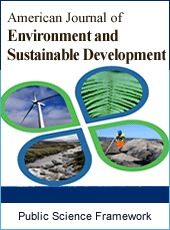American Journal of Environment and Sustainable Development
Articles Information
American Journal of Environment and Sustainable Development, Vol.5, No.4, Dec. 2020, Pub. Date: Dec. 24, 2020
Impact of Community Involvement in Environmental Protection in Rwanda
Pages: 83-88 Views: 1674 Downloads: 277
[01]
Clemence Idukunda, Faculty of Environmental Studies, University of Lay Adventists of Kigali (UNILAK), Kigali City, Rwanda.
[02]
Viateur Ntarindwa, Rural Development Inter-Diocesan Service (RDIS), Muhanga, Rwanda.
[03]
Eric Bagenzi, Rural Development Inter-Diocesan Service (RDIS), Muhanga, Rwanda.
[04]
Lamek Nahayo, Faculty of Environmental Studies, University of Lay Adventists of Kigali (UNILAK), Kigali City, Rwanda.
The involvement of local community is crucial in ensuring sustainable protection of environment since the community uses the available resources without thinking of future generations. In developing countries like Rwanda, natural resources and environment are the primary sources of livelihoods; hence their protection is of great importance to community welling and sustainable development as well. This study assessed the impact of community involvement in environmental protection. The authors conducted a pilot study for the project led by the Rural Development Inter-Diocesan Service (RDIS) and considered three sectors (Kibilizi, Kansi and Gikonko) of Gisagara district in the southern Rwanda. The authors randomly selected thirty (30) respondents from the above three sectors. The structured questionnaire helped to collect the study related information analyzed with Microsoft Excel. The results indicated that 77% of respondents were female while 23% were male and more than 60% were aged between 36 and 50. The informants largely (53%) raised the cutting off trees without permission as a cause of environmental degradation. This was attributed to collection of and/or search for firewood mentioned by 67%. However, using of improved cook stoves as the initiative developed, as mentioned by 100% led to the reduction of pressure on woodlands, reduction of indoor air pollution and improvement of the local families’ lives. Thus, the RDIS initiatives contributed to protecting environment in this area. However, since the percentage of using improved cook stoves is still low compared to the total population, it is good to continue mobilizing the community to refer to this approach. In addition, more sensitization mainly increasing people’s literacy as well as increasing local community’s livelihoods would contribute a lot to environmental protection. This study can serve as guiding tool to policy makers while planning environmental protection measures.
Community Involvement, Environmental Protection, Gisagara District, Rwanda
[01]
Khalili, N. R., & Duecker, S. (2013). Application of multi-criteria decision analysis in design of sustainable environmental management system framework. Journal of Cleaner Production, 47, 188-198.
[02]
Mazimpaka, E. (2014). Woodfuel in Rwanda: Impact on Energy, Poverty, Environment and Policy Instruments analysis. International Journal of Renewable Energy Development, 3 (1).
[03]
Karamage, F., Shao, H., Chen, X., Ndayisaba, F., Nahayo, L., Kayiranga, A.,.. & Zhang, C. (2016). Deforestation effects on soil erosion in the Lake Kivu Basin, DR Congo-Rwanda. Forests, 7 (11), 281.
[04]
Andrew G, Masozera M. Payment for ecosystem services and poverty reduction in Rwanda. J Sustain Develop Afr 2010; 12: 122-39.
[05]
Moodley, V., Gahima, A., & Munien, S. (2010). Environmental causes and impacts of the genocide in Rwanda: Case studies of the towns of Butare and Cyangugu. African Journal on Conflict Resolution, 10 (2).
[06]
Ordway, E. M. (2015). Political shifts and changing forests: Effects of armed conflict on forest conservation in Rwanda. Global Ecology and Conservation, 3, 448-460
[07]
Blackie LE, Jayawickreme E, Forgeard MJ, Jayawickreme N. The protective function of personal growth initiative among a genocide-affected population in Rwanda. Psychological Trauma: Theory, Research, Practice, and Policy 2015; 7: 333.
[08]
Rubimbura, V. M., Idukunda, C., Nsanzabaganwa, J., Yambabariye, E., Nahayo, L., & Maniragaba, A. (2020). Impact of Community Behavior Change on Environmental Protection in Rwanda. Journal of Environment Protection and Sustainable Development, 6 (1), 11-15.
[09]
RDIS, Carbon Emission Reduction for Self Sustainable Environmental Care (CCER), Narrative Report of the Activities carried out from May 2017- December 2019
[10]
Berger, K. and Garyfalakis, E., (2012), Environmental Impact Assessment of road transportation – Analysis to measure environmental impacts of road transportation based on a company case. Master’s thesis, Jönköping University.
[11]
Harelimana, V., Gao, Z. J., Nyiranteziryayo, E., & Nwankwegu, A. S. (2020). Identification of weaknesses in the implementation of environmental impact assessment regulations in industrial sector: A case study of some industries in Rwanda, Africa. Journal of Cleaner Production, 120677.
[12]
Kabera, T. (2017). Environmental impact assessment in higher education institutions in East Africa: the case of Rwanda. Environmental Science and Pollution Research, 24 (8), 7852-7864
[13]
REMA (2014), Rwanda Environment Outlook issue 002 July 2014, managing natural resources for sustainable development, Kigali, Rwanda.
[14]
Bikorimana, G., & Sun, S. (2020). Poverty and environmental degradation nexus in Rwanda: any empirical evidence. Interdisciplinary Environmental Review, 20 (2), 136-158.
[15]
Gasana, S-H. F., et al. (2015), Assessment of Environmental Health Impact of ores mining project in Nyaruguru District, RWANDA: A perspective for Sustainable Development.

ISSN Print: Pending
ISSN Online: Pending
Current Issue:
Vol. 6, Issue 4, December Submit a Manuscript Join Editorial Board Join Reviewer Team
ISSN Online: Pending
Current Issue:
Vol. 6, Issue 4, December Submit a Manuscript Join Editorial Board Join Reviewer Team
| About This Journal |
| All Issues |
| Open Access |
| Indexing |
| Payment Information |
| Author Guidelines |
| Review Process |
| Publication Ethics |
| Editorial Board |
| Peer Reviewers |


